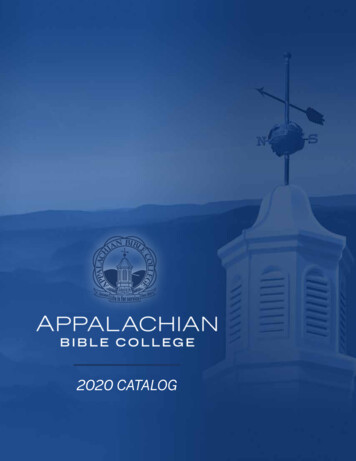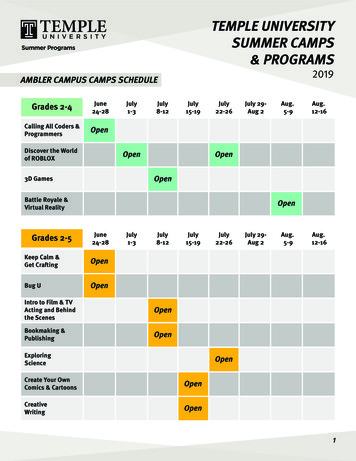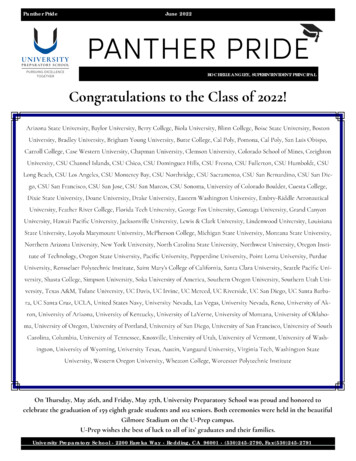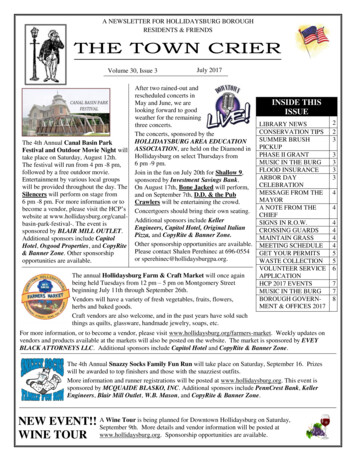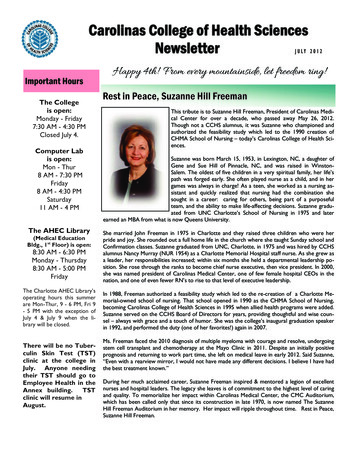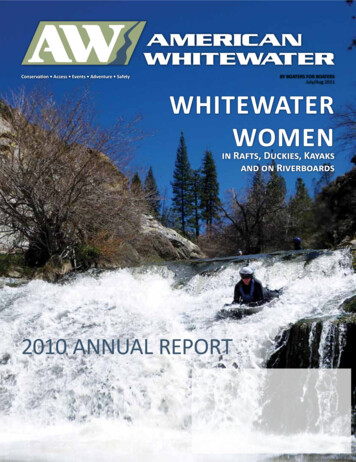
Transcription
Conservation Access Events Adventure SafetyBY BOATERS FOR BOATERSJuly/Aug 2011WhitewaterWomenin Rafts, Duckies, Kayaksand on Riverboards2010 Annual Report
A VOLUNTEER PUBLICATION PROMOTING RIVER CONSERVATION, ACCESS AND SAFETYAmerican Whitewater JournalJuly/Aug 2011 – Volume 51 – Issue 4Columns5 The Journey Ahead by Mark Singleton6 President’s Message by Norwood Scott9 Paddler Fitness by John Amtmann and Meaghen Randall30Rivers of India by Stephen Cunliffe34 News & Notes48Annual Report70Letters to the EditorStewardship7Another Hydropower Threat Averted by Megan HookerWhitewater Women11River Lessons by Jen Cline13Whitewater Brings us Together by Jen Burks14Kayaking Journey by Kelsey Bracewell16Kayaking, a Way of Life by Aidan Amtmann18Still Lying Down on the Job by Rochelle Parry20From Scaredy Cat to River Rat by Shelley Poli22Who Needs Boys? by Stacy Falk28Getting my Roll on by Jennifer S. DailRiver Voices42Greening out in Montreal by Ruben Hudson45Río Piaxtla by Rocky ContosAlicia Monahan, sliding downBrush Creek (CA).Photo by Josh Galt,Face Level IndustriesPublication Title: American WhitewaterIssue Date: July/Aug 2011Statement of Frequency: Published BimonthlyAuthorized Organization’s Name and Address:American WhitewaterP.O. Box 1540Cullowhee, NC 28723
PURPOSERiver Stewardship:An Integrated ApproachOur mission: “To conserve and restore America’swhitewater resources and to enhance opportunitiesto enjoy them safely,” is actively pursued throughour conservation, access, safety and education effortsunder the umbrella of River Stewardship. The onlynational organization representing the interest ofall whitewater paddlers, American Whitewater is thenational voice for thousands of individual whitewaterenthusiasts, as well as over 100 local paddlingclub affiliates.AW’s River Stewardship program adheres to the fourtenets of our mission statement:CONSERVATION: AW’s professional staff worksclosely with volunteers and partner organizationsto protect the ecological and scenic values of allwhitewater rivers. These goals are accomplishedthrough direct participation in public decision-makingAmerican WhitewaterJournal StaffEditor Ambrose TuscanoP.O. Box 913, Soda Springs, California 95728e-mail: editor@americanwhitewater.orgGraphic Design/Production/Photo Editor Megan SeifertAssistant Editors Erica J. Seifert, Barry TuscanoContributing WritersMark Singleton, Norwood Scott, Megan Hooker, John Amtmann,Meaghen Randall, Jen Cline, Jen Burks, Kelsey Bracewell, AidanAmtmann, Rochelle Parry, Shelley Poli, Stacy Falk, Jennifer S.Dail, Stephen Cunliffe, Bethany Overfield, Eugene Buchanan,David Hughes, Scott Martin, Angela Baldo, Collin Whitehead,Ruben Hudson, Rocky ContosPhoto ContributorsTyler Roemer, John Amtmann, Anna Levesque, Rob Zabel,Hannah Culwell, Patrick Cindrich, Mike Malament, Josh Galt,Ohiopyle Adventure Photography, Garth Brown, Stephen REP,21st Century Parks, Inc., John Nations, Anglea Baldo, CanyonsInc., Cristie Scott, Ashleigh Tucker, Katrina Heyde, Don Hudson,Josephine EwingEvents / Advertising Coordinator Jeff PaineP.O. Box 1540, Cullowhee, NC 28723phone 860-331-8323e-mail: jeff@americanwhitewater.orgSafety Editor Charlie WalbridgeRoute 1, Box 329F, Bruceton Mills, WV 26525e-mail: ccwalbridge@cs.comStewardship Reports EditorKevin Colburn, kevin@americanwhitewater.orgMissing Copies and Address ChangesCarla Miner, carla@americanwhitewater.orgAmerican Whitewater is printed by Boyd Brothers Printing, Panama City, Florida.All rights reserved.EDITORIAL DISCLAIMERThe opinions expressed in the features andeditorials of American Whitewater are those ofthe individual authors. They do not necessarilyrepresent those of the Directors of AmericanWhitewater or the editors of this publication.On occasion, American Whitewater publishesofficial organizational policy statements draftedand approved by the Board of Directors. Thesepolicy statements will be clearly identified.4 processes, grassroots advocacy, coalition building,empowerment of volunteers, public outreach andeducation, and, when necessary, legal action.RIVER ACCESS: To assure public access to whitewaterrivers pursuant to the guidelines published in itsofficial Access Policy, AW arranges for river accessthrough private lands by negotiation or purchase,seeks to protect the right of public passage on all riversand streams navigable by kayak or canoe, encouragesequitable and responsible management of whitewaterrivers on public lands, and works with governmentagencies and other river users to achieve these goals.SAFETY: AW promotes paddling safely, publishesreports on whitewater accidents, maintains a uniformnational ranking system for whitewater rivers (theInternational Scale of Whitewater Difficulty) andpublishes and disseminates the internationallyrecognized American Whitewater Safety Code.whitewater rivers, as well as river recreation,conservation, access, and safety. This is accomplishedthrough our bimonthly AW Journal, a monthly e-news,americanwhitewater.org, paddling events, educationalevents, and through direct communication withthe press.Together, AW staff, members, volunteers, and affiliateclubs can achieve our goals of conserving, protectingand restoring America’s whitewater resourcesand enhancing opportunities to safely enjoy thesewonderful rivers.AW was incorporated under Missouri nonprofitcorporation laws in 1961 and maintains its principalmailing address at PO Box 1540, Cullowhee, NC 28723;phone 1-866-BOAT-4-AW (1-866-262-8429). AW istax exempt under Section 501 (c) (3) of the InternalRevenue Service.EDUCATION: AW shares information with thegeneral public and the paddling community regardingBoard of Directors & StaffBOARD of DirectorsChris Bellchris@boatingbeta.comAsheville, NCRich Bowersrich@hydroeform.orgBellingham, WADave Cernicekcernicek@cluemail.comJackson, WYAdam Cramercramerica@gmail.comBethesda, MDLeland Davisleland@brushmountainpublishing.comSwannanoa, NCKent Fordkent2003@performancevideo.comDurango, COJennie Goldbergjennie@nwwhitewater.orgSeattle, WAChristopher Hestkayakasia@yahoo.comSan Francisco, CADon Kinserdkinser@ediltd.comMarietta, GAEvie Lockeevelynlocke@verizon.netCharlemont, MANorwood Scottwns111@sbcglobal.netSan Francisco, CACharlie Walbridge, Honoraryccwalbridge@cs.comBruceton Mills, WVCourtney Wiltoncourtneywilton@gmail.comPortland, ORBOARD OFFICERSPresident: Norwood ScottVice President: Chris BellSecretary: Jennie GoldbergTreasurer: Don KinserAt Large: Kent Ford andEvie LockeAW STAffLaura BlalockFinance ManagerCullowhee, NClaura@americanwhitewater.orgKevin ColburnNational Stewardship DirectorMissoula, MTkevin@americanwhitewater.orgNathan FeyColorado Stewardship DirectorLongmont, COnathan@americanwhitewater.orgMegan HookerStewardship AssistantPortland, ORmegan@americanwhitewater.orgJay LoschertDolores River StewardshipAssistantDolores, COjay@americanwhitewater.orgCarla MinerMembership ManagerWest Valley City, UTcarla@americanwhitewater.orgJeff PaineOutreach DirectorAsheville, NCjeff@americanwhitewater.orgThomas O’KeefePacific NW Stewardship DirectorSeattle, WAokeefe@americanwhitewater.orgMark SingletonExecutive DirectorCullowhee, NCmark@americanwhitewater.orgDave SteindorfCalifornia Stewardship DirectorChico, CAdave@americanwhitewater.orgTOLL FREE NUMBER1-866-262-8429americanwhitewater.org
The journey aheadIn this issue of the American WhitewaterJournal the staff and board share our2010 Annual Report with you. Whilelast year provided challenging economicconditions, American Whitewater focusedon our core river stewardship program anddelivered outstanding project successes.Some of these river stewardship stories areshared in our Annual Report as a sample ofthe types of projects we undertake and themethods we employ for long-term success.At the heart of our river stewardshipprogram is the understanding thatconservation and recreation are mutuallydependant. Time spent paddling forms thealso utilizing additional professional servicesto assist in our story telling and outreachabout the importance of flows in rivers,not only for recreation but for restorationof the resource as well. This additionalbandwidth helps American Whitewateraddress the increasing demands beingplaced on the stewardship efforts of ourorganization as water allocation discussionsramp up across the country.So please take some time in this AmericanWhitewater Journal to read through ourAnnual Report on page 48. You’ll seethat we have a good story to tell aboutreal differences being made to protectthe places we all value as paddlers.Our partnership between our Board ofDirectors and professional staff is strongand functioning at a high level. There hasnever been a better time to be an AmericanWhitewater member and make a realFinally, we just completed our annual difference in the stewardship of our rivers.face-to-face Board of Directors meetingin North Bend, WA. Our board has the See you on the river,foresight to implement a succession planthat takes American Whitewater throughFew organizations accomplish the same level ofresults with the limited resources of AmericanWhitewater. Each membership dollar that AWreceives is leveraged to generate 5 in totalfunding directed at supporting river stewardship.basis for a conservation ethic that valueswater in rivers. Paddlers understand thatyou cannot love what you don’t know. It’sour love of whitewater that makes us fiercedefenders of rivers and their flows. Thisintimate connection to flowing water hasmade American Whitewater a force in riverstewardship for over 50 years.Few organizations accomplish the samelevel of results with the limited resourcesof American Whitewater. Each membershipdollar that AW receives is leveraged togenerate 5 in total funding directedat supporting river stewardship. The 1to 5 ratio is achievable because AW isable to attract support from foundations,private donors, advertising opportunities,events and partnerships. As a result, yourmembership dollar goes five times as far inthe protection of whitewater rivers.As we move into the future, we are addingcapacity to our river stewardship program.This year, we have hired two stewardshipassistants to provide additional support forprojects in California and Colorado. We areJuly/Aug 2011 Mark SingletonExecutive Director, American Whitewaterthe next decade of board leadership withan organized officer transition process inplace. This plan helps to ensure an orderlytransition of board members over time andaddresses the need for broad geographicand talent diversity among our Directors.At our North Bend meeting our Directorselected new board officers as follows:Norwood Scott (CA) – PresidentChris Bell (NC) – Vice PresidentDon Kinser (GA) – TreasurerJennie Goldberg (WA) – SecretaryServing with this group of officers on theAmerican Whitewater Executive Committeeare two at large members, Evelyn Locke(MA) and Kent Ford (CO).Please join with me in welcoming NorwoodScott and the rest of the officers to theirnew leadership roles with AmericanWhitewater. Remember that our boardis comprised of volunteers who give theirtime, energy and passion to the governanceof American Whitewater.5
President’s MessageIhope that, as you read this letter, youhave all had an opportunity to takeadvantage of an epic spring boatingseason and are enjoying the warmersummer months. I’m very pleased tohave been elected your next AmericanWhitewater President. Though it will bedifficult to fill the shoes of Don Kinser,who has been instrumental in leading AWover the past three years, I am up for thechallenges ahead.AW consists of a strong team of dedicatedindividuals—from our extremely effectiveExecutive Director, Mark Singleton, to ourexperienced staff, knowledgeable board,and motivated volunteers and members.I’m honored to work with all of you, aswell as our stakeholders to create an evenstronger organization and continue topursue our mission.I’m often asked what my primary goals willbe for the next three years, while servingas Board President. AW is a 1.2 millionorganization, which represents 5,200 directdues-paying members, 120 affiliate clubs,and a community of 30,000 whitewaterpaddlers across the nation. I would liketo increase our budget so we can hiremore staff and contractors who can helpus accomplish even more than our leanorganization does currently.philanthropy experience. Christopher willbe working with Kent Ford and others toeducate potential donors about our workand seek their financial assistance. If youknow of potential donors, and would bewilling to meet with them, we will offer youany assistance that you may need. Pleasedon’t hesitate to call on us for help.Another area I would like to see AW improvein is our website. We recently completedan audit of our website, which scolded usrather firmly for its current deficiencies.We need a website that serves our mission,and is a go-to resource for all of you. If it iscost-effective in the long run to make majordesign changes to our website, then I wouldlike to see such changes happen sooner,rather than later. This may be an expensiveundertaking for AW so if you know any webdesign firms that believe in our cause andlike to do pro bono work for non-profits,please let us know!In closing I want to thank all of you foryour support. I look forward to being yourPresident and I know we can accomplishgreatness together.Hope to see you on the river soon,Our membership numbers have been W. Norwood Scottflat for the last few years so this is anarea where I plan to focus my attention.During our May board meeting in NorthBend, Washington, we implemented amembership strategy that includes aboard competition to increase membershipnumbers. I will be reporting the resultsto our Executive Committee each monthduring our regularly scheduled conferencecalls. I’m asking for your assistance too—please help us increase membership.In May we started a DevelopmentCommittee, chaired by Christopher Hest,a California board member with extensive6 americanwhitewater.org
StewardshipAnother HydropowerThreat averted: WhiteRiver Falls, ORby Megan HookerOur nation’s rivers are underincreased pressure and threatfrom new hydroelectric projectsas we seek to increase carbon-neutralenergy production in the face of globalclimate change. These proposed hydroprojects are popping up throughout theU.S. And while the Pacific Northwest is inthe spotlight for removing dams, includingthe Hemlock, Marmot, Condit, Elwha, andGlines Canyon Dams, the region is notexempt from these pressures.In 2010, the Northern Wasco County PublicUtilities District (“NWCPUD”) revived adecades old plan to rehabilitate an oldhydroelectric plant for new productionat White River Falls in Oregon. The WhiteRiver plunges over a 90-foot basalt shelfto create the Falls, and the scenery drawspeople from around the region all yearlong. The lower tier of the falls is known tokayakers as Celestial Falls, and was a greatrunnable waterfall prior to a decision by theState Parks to close the falls to recreation.The White River’s headwaters are fedby an active glacier on the southeasternslopes of Mt. Hood, and the river flows53 miles through forest, agricultural anddesert lands before its confluence with theDeschutes River.The White River and White River Fallshave been recognized for protection innumerous ways. In 1988, the White Riverwas designated Wild and Scenic for itsoutstanding geology, fish habitat, wildlife,recreation and scenic resource values.The entire length of the river was giventhis designation, except for a 0.6-milestretch around White River Falls, whichwas later recommended for inclusionin the Wild and Scenic system. The riverwas also recognized for its conservationvalue by the Northwest Power andConservation Council, which identified itJuly/Aug 2011 Celestial Falls, the lower tier of White River Falls (OR), is safe from dewatering by ahydroelectric project once again. Efforts continue to focus on opening the falls to legalpaddling, which has been off limits for a decade.Photo by Tyler Roemeras a “Protected Area.” Rivers included in unacceptable risk of irreversible loss to fishthese areas represent special places where and wildlife. The state has also recognizedhydroelectric development would pose an the value of the water in the river at the7
StewardshipFalls, and holds two instream water rightsfor the area—one for the protection ofaquatic life and the other for preservationof the scenic values at White River Falls andthe state park that surrounds it.Hydropower was originally developedat White River Falls in the early 1900s,and operated until the Dalles Damwas completed on the Columbia Riverin the 1960s. When the project wasdecommissioned, the dam, diversion works,portions of the penstocks and powerhousewere left behind. In 1983, NWCPUD appliedfor a license to rehabilitate the old projectfor hydroelectric production, but at the timethe project was found to be economicallyinfeasible. NWCPUD ultimately decidednot to pursue production and formallysurrendered its license in 1995.In an effort to provide additionalincremental power supply resourcesrequired under federal power obligations,the NWCPUD sought to revive the projectagain in 2010. The project was found to befeasible only if the facility could use up to450 cfs streamflow for power productionbetween October 31 and May 31.American Whitewater and our fellow riverconservation partners were concerned thatthe project would impact instream flowsthat make White River Falls a valuablescenic resource, and in late 2010, we fileda motion to intervene in the applicationfor the preliminary permit to the FederalEnergy Regulatory Commission.Shortly thereafter, plans to revive theproject hit a snag when the scenic waterright for White River Falls, which hadpreviously not surfaced in the projectscoping process, was discovered.While NWCPUD held a water right forhydroelectric production for the site inthe 1990s, the utility requested that theright be surrendered after they decided notto pursue the project. The Oregon WaterResources Department cancelled the right,and in December of 1994, the OregonWater Resources Control Board filed forand approved an instream scenic water8 right at White River Falls on behalf of theOregon Parks and Recreation Department.Modeling of the project showed that itwould not be possible to meet flow needsfor hydroelectricity and the requirementsof the instream scenic water right at thesame time. NWCPUD explored their optionsfor challenging the instream water right,but ultimately decided not to pursuethe issue.In March 2011, the project was once againdeemed to be economically infeasible,and the falls and adjoining state parkwere spared further development. Whilehydroelectric developers are aggressivelypursuing new projects, White River Fallsis a prime example of what we are seeingacross the country. Such projects arefinancially and environmentally costlywith little promise of return in electricityproduction. American Whitewater supportsa final Wild and Scenic designation forWhite River Falls to protect the area fromfuture development.While the hydroelectric story has been laidto rest for the time being, the recreationstory continues. The lower falls at WhiteRiver Falls, Celestial Falls, is still closed forwhitewater boating. Historically, CelestialFalls was recognized as one of the bestwaterfalls in the country for paddlers tosharpen their big drop skills on. In 2001,Oregon Parks and Recreation “closed” thefalls at the state park to kayaking, citingsafety concerns. This decision came despitethe fact that recreational use of the lowerfalls for kayaking is specifically referencedin the river management plan. AmericanWhitewater has long regarded this closureas inconsistent with state and national rivermanagement practices. Waterfall banshave generally been temporary on riverswhere they have been instituted, and wecontinue to work to restore whitewaterboating as a valid activity at Celestial Falls.americanwhitewater.org
Paddler FitnessPaddler Health andFitness: Where toBegin?by John Amtmann andMeaghen RandallLast time in this space we discusseda plan to improve paddlers’cardiorespiratory fitness. In thisinstallment, we ask, “How do we put it alltogether to develop a program that willimprove all of the fitness components forthe river recreationalist?” To some, “puttingit all together” sounds so daunting thatit gets put off indefinitely. It’s importantto remember that procrastination is the A beginner’s program is one that I considerenemy of health and fitness improvements. using for someone who hasn’t exercisedDo it today!in more than six months to a year. Thosewho have been sedentary for that longConsider this: Approximately 75% of all need time for their body to adapt to aAmericans are either completely sedentary regular regimen of physical activity. Theor inadequately active, which means they guidelines for improving health and fitnessare not getting more than 2 days per week of are general enough to allow for morephysical activity. These numbers probably than one approach to improving fitness.reflect the river enthusiast community Some experts believe in the comfortableas well. We Americans are creative in approach, and schedule a somewhat gentleformulating excuses for why we should not total of four days per week of exercise.be exercising today. Many, however, just Program A is one example of a beginningdon’t know where to start. This article will balanced exercise program of four sessionsdescribe some lower intensity programs per week:– programs I have actually prescribed forindividuals who just didn’t know how to Program Abegin. If you fall into this category, youshould be aiming for about an hour of Mondays and Thursdaysmoderate to intense and balanced physicalactivity every day. Warm-up for 10 minutesAbdominal curlPhoto by John Amtmann Cardio for 20 minutes Strength training:1. Leg press2. Leg extension3. Leg curl4. Lat Pull Down5. Dumbbell bench press6. Abdominal curl7. Back extension Cool down and stretchTuesdays and Fridays Warm-up for 10 minutes Cardio for 30 minutes Cool down and stretchSpecific Guidelines for Program A1. To begin each session, warm-up: Just likeit’s a good idea to warm up the shouldersbefore paddling, it’s a good idea to warm upthe body before exercising. Don’t dismissit. Walk, jog, jumping jacks—anything toincrease body temperature for 10 minutes.Back Extension.Photo by John AmtmannJuly/Aug 2011 9
Paddler FitnessDumbbell bench pressPhoto by John Amtmannof cardio and three days per week ofstrength training.Program BMondays, Wednesdays, and Fridays2. Each and every session should end with 7. Strength training repetitions musta cool down including some effective follow these requirements:and focused stretching. This topic will bea. three seconds to raise the weightcovered in a future issue.b. two second pausec. four seconds to lower the weight3. The intensity of the cardio session shouldbe monitored by palpating heart, and 8. Record weights and reps in a journalintensity should be adjusted to keep the so you know what you’ve done and whatheart rate in the appropriate range rate your session goals will be.(both heart rate monitoring and rangeswere covered in the previous issue of This program requires a commitment ofAmerican Whitewater).four days per week. Some river enthusiasts,however, are more comfortable with a six4. Perform one set of each exercise. During day per week commitment. If you feelthe first week, take the time to learn the better able to maintain the fitness schedulemovements well. Do not complete each set every day during the workweek and haveto fatigue or failure until the second or third the time to exercise once each weekendweek when the movements begin to feel then Program B is for you. It modifies themore comfortable. Beyond the third week above program for three days per weekhowever, each set should be to muscularfatigue or failure—until you can’t continuethe movement with good form. Warm-up for 10 minutes Cardio for 20 minutes Strength:1. Leg press2. Leg extension3. Leg curl4. Lat Pull Down5. Dumbbell incline or benchpress6. Abdominal curl7. Back extension Cool down and stretchTuesdays, Thursdays and Saturdays Warm-up for 10 minutes Cardio for 30 minutes Cool down and stretchAny river rat not regularly exercising shouldtry one of these programs to help improvetheir fitness today!5. Do 8-15 repetitions for each exercise,except for the abdominal curl and the backextensions. Complete up to 30 repetitionsfor each of these. When 30 can be done,hold weight to increase resistance.6. When 15 reps can be completed for theother exercises, increase the weight for thenext workout.Lat pull downPhoto by John Amtmann10 americanwhitewater.org
Whitewater WomenRiver LessonsIby Jen Clinehave a huge sense of adventure. Ithought my former husband did too, untilone morning at breakfast he proclaimed,“Marriage is boring,” and sure enough, heleft a few months later.I realize now that some people can substitutesensation for emotion. This means that thesensation that an activity provides (rockclimbing, paddling, any extreme sport)replaces the feelings the person may beavoiding. I am the opposite: the outdooractivities I enjoy intensify the emotions Iam feeling and I feel more connected to theoutdoors and those around me. Gripping arock face with my backside hanging out inthe breeze has always been a huge thrill forme. Peering down a wide open bowl on skisover looking the Rocky Mountains is evenbetter. Backpacking is slow and arduous butwhen I start out on a solo trip, I am nervousand excited all at once.It comes as no surprise that I would beinterested in kayaking. I love water andgetting wet, and kayaks are the “sports carsof the wilderness.” They are compact, sleek,and fast. With the US National WhitewaterCenter just 20 minutes from my house,it was too tempting to learn. I signed upfor a package of lessons last fall and wassoon rolling my kayak inconsistently andpaddling the Wilderness channel (Class III).I laughed at myself because every time I hit“M wave,” the largest wave on the channel,I would shut my eyes and scream.The first week in November my neighborinvited me to paddle the Upper Green.Many experienced paddlers were going,and “newbies” were welcome.“Am I ready for a real river?” I asked.“Absolutely,” Will replied.“Besides,” he said, “Sanders and I will bethere to look out for you.”July/Aug 2011 I needed to find a paddle, gear to keepme warm, and a babysitter for my kids.I was skeptical I could pull it all off, andlet the week go by. Will called me againon Saturday,“C’mon, Jen, I think you should go,” he said.It was a good opportunity, I realized, and Ishould make every effort to experience it.Will lent me the gear I needed, I ran up toGreat Outdoor provisions (GOP) to buy apaddle but because they were sold out ofmy size, they lent me a demo paddle formy trip. A call to my former husband, andhe agreed to be at my house at 5:30 am tostay with the kids. I was in.Sanders and Will picked me up dirt earlyand we were off to the mountains aftermeeting the rest of the group. When wearrived at the put-in, I quickly got geared upand waited for the others. I stood looking atthe river and the gorgeous trees droppingtheir leaves in the water. I also listened andwatched the water slap against the rocksand was amazed at how it was constantlyflowing. The mist was rising and the scenewas gorgeous. I decided privately at thatmoment to dedicate the day to one of myformer patients at the hospital.The author at Bayliss Boof on theUpper Green (NC).Photo by Anna LevesqueShe was a 32-year-old pregnant womanwrought with cancer. I treated her off andon for four months, and as her physicaltherapist, it was my job to make herstronger. Her goals were to transfer into awheelchair to visit her son in the NeonatalInstensive Care Unit (NICU) every day (shedelivered in August) and to go home forThanksgiving. She fought hard, and despitebeing paralyzed from the waist down, andbattling severe pain on a daily basis, shenever refused a therapy session. She wasvibrant, and funny, but most of all, she wasbrave. It wasn’t enough though. She haddied earlier in the week. In honor of her, Idecided to be brave on the river that day.I felt lucky to be healthy and strong at 40years old, and didn’t want to shy away fromany challenges.Forty minutes into the trip, I flipped mykayak and was pinned against rock. I lostmy paddle, but Will and Sanders were therein a flash. Will helped me retrieve my boatand Sanders found my paddle. I kept mycalm the entire time. Ten minutes later wepulled our boats over to the side of the riverto scout a rapid. It looked scary, a fairly bigdrop, and I watched guys paddle over it.11
Whitewater WomenThe author with her children, Tommy andtolerable because I was so happy aboutKatelyn Cline.my accomplishment.Photo by Rob ZabelI paddled down the rapids, spun my boat atthe bottom, but landed square in the water.My first Class III rapid on a real river and Iwas upright. I was beaming and so in themoment that I barely heard the cheers ofthe 18 men I was paddling with.We returned home and my kids wereexcited to hear about my day. I wentthrough the details and shared with themhow my patient inspired me. “How did sheconspire (inspire) you, Mommy,” my sevenyear-old son inquired.“Did you hear them cheering for you?” Will “When people are brave during scary orasked, when we reconvened.sad moments, it makes you want to belike them,” I replied. At that point I wasn’tWe continued down the rest of the river, sure if I was referring to my handling of mythrough two more Class III rapids and my former marriage, or my first real river trip,lines were good. I flipped one other time, or my patient from the hospital, but it reallydidn’t manage a roll, but a friend was there didn’t matter. My kids got it, and I felt moreand he flipped me back up again. The connected to them than ever.day was perfect. The sun came out and“You
RIVER ACCESS: To assure public access to whitewater rivers pursuant to the guidelines published in its official Access Policy, AW arranges for river access through private lands by negotiation or purchase, seeks to protect the right of public passage on all rivers and streams navigable by kayak or canoe, encourages
